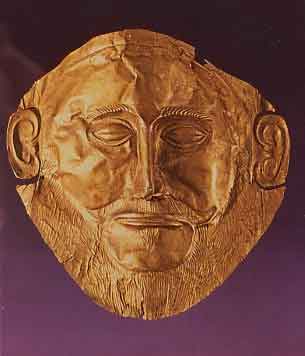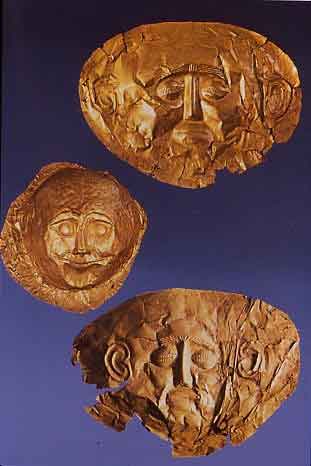"I have gazed upon the face of Agamemnon," archaeologist Heinrich Schliemann exclaimed after discovering a gold leaf mask at the citadel of Mycenae. The mask was found still on its corpse in a shaft grave of Grave Circle A and was in fact one of five masks discovered, but due to its nobility and level of preservation Schliemann claimed it to be that of the famous king. Modern research, however, has actually dated the mask to about 1550-1500 BCE, which is three-hundred years before Agamemnon, if he did exist, would have lived. Much controversy has come up regarding the identity of the mask with many people calling Schliemann a fraud. Nonetheless, not all bodies were buried with such riches and the mask still indicates that it covered somebody of some sort of importance, presumably some other Mycenaean king.
The mask was created by hammering gold into a thin leaf over a wooden form. It is three-dimensional and includes cut-out ears, full detailed facial hair, and eyelids that appear open and closed simultaneously. Because of its uniqueness it has come to be representative of gold-work from the age. Gold had also been found fashioned into many other forms including rosettes, butterflies, and gold rings that show scenes of fighting or scenes of religious importance. While these pieces were probably used in everyday life, they are now found in the context of the graves.
Today, the mask of “Agamemnon” resides in the National Archaeological Museum in Athens.

Gold mask thought to be the likeness of Agamemnon

Other gold masks found in graves at Mycenae
Works Cited:
Biers, William R. The Archaeology of Greece. Ithaca: Cornell University Press, 1996.
Whitley, James. The Archaeology of Ancient Greece. Cambridge: Cambridge University Press, 2001.
Posted at Dec 12/2007 07:59AM:
keffie: Nice work. You do a good job of addressing the history, interpretation, and even a little about production.
Posted at Dec 13/2007 11:44PM:
Harry Anastopulos: It's always a toss-up when it comes to sites of importance from literary texts...much of early archaeology seems to have aimed at confirming textual accounts. Schliemann seems to have been no exception!
